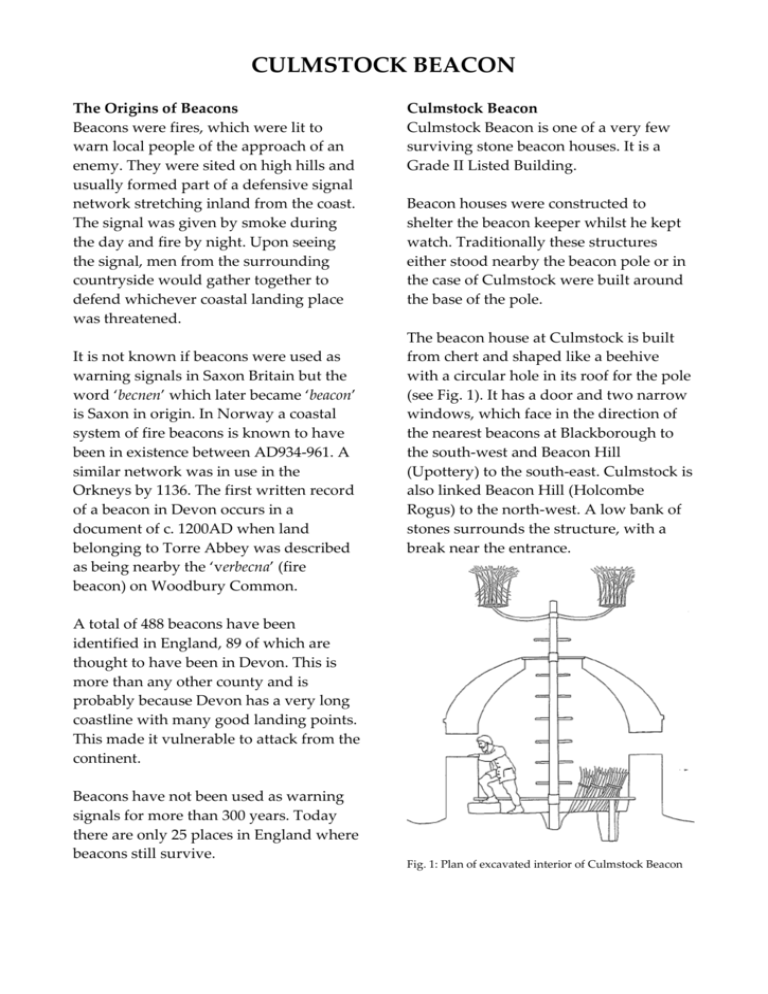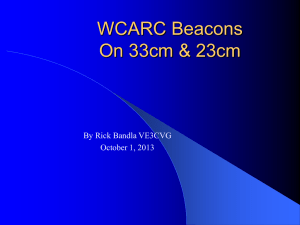Fig. 2: Plan of excavated interior of Culmstock Beacon
advertisement

CULMSTOCK BEACON The Origins of Beacons Beacons were fires, which were lit to warn local people of the approach of an enemy. They were sited on high hills and usually formed part of a defensive signal network stretching inland from the coast. The signal was given by smoke during the day and fire by night. Upon seeing the signal, men from the surrounding countryside would gather together to defend whichever coastal landing place was threatened. It is not known if beacons were used as warning signals in Saxon Britain but the word ‘becnen’ which later became ‘beacon’ is Saxon in origin. In Norway a coastal system of fire beacons is known to have been in existence between AD934-961. A similar network was in use in the Orkneys by 1136. The first written record of a beacon in Devon occurs in a document of c. 1200AD when land belonging to Torre Abbey was described as being nearby the ‘verbecna’ (fire beacon) on Woodbury Common. Culmstock Beacon Culmstock Beacon is one of a very few surviving stone beacon houses. It is a Grade II Listed Building. Beacon houses were constructed to shelter the beacon keeper whilst he kept watch. Traditionally these structures either stood nearby the beacon pole or in the case of Culmstock were built around the base of the pole. The beacon house at Culmstock is built from chert and shaped like a beehive with a circular hole in its roof for the pole (see Fig. 1). It has a door and two narrow windows, which face in the direction of the nearest beacons at Blackborough to the south-west and Beacon Hill (Upottery) to the south-east. Culmstock is also linked Beacon Hill (Holcombe Rogus) to the north-west. A low bank of stones surrounds the structure, with a break near the entrance. A total of 488 beacons have been identified in England, 89 of which are thought to have been in Devon. This is more than any other county and is probably because Devon has a very long coastline with many good landing points. This made it vulnerable to attack from the continent. Beacons have not been used as warning signals for more than 300 years. Today there are only 25 places in England where beacons still survive. Fig. 1: Plan of excavated interior of Culmstock Beacon Culmstock Beacon contd…. The threat of the Spanish Armada in 1588 resulted in the people of Devon (and other counties) hurriedly repairing all existing beacons, whilst constructing many more. Although it has been suggested that Culmstock beacon house was probably constructed during this period, it could be of an earlier possibly medieval date. Donn’s map of 1765 shows it as ‘Blackdown Beacon’. In 1870 the structure was described as being ‘fallen abroad’. The current structure is thought to be a rebuild of an earlier structure, the remains of which may be represented by a circular feature to the north of the building. The dimensions of this site match those of Hutchinson’s description in 1851. Archaeological Investigations Culmstock Beacon is the only beacon site to have been excavated. In 1995 a small excavation within the interior of the stone structure identified seven post-holes: one in the middle for the beacon pole and six around the inside of the stone wall (see Fig. 2). These post-holes once held the thick wooden stakes, which were driven into the ground to help hold the beacon pole in position. The stakes were probably connected to struts, which radiated from the central pole like the spokes of a wheel. Evidence for these wooden struts also survives in the stone-wall where small sockets can still be seen some 0.20m above ground level. Fig. 2: Plan of excavated interior of Culmstock Beacon Further Reading Anon, 1985, ‘Armada Preparations’ in Aspects of Devon History Devon County Council, 2000, ‘Fire Beacons: Warning Signals Across the Countryside’ Polwhele, R., 1793-1806, The History of Devonshire Russell, P., 1955, ‘Fire Beacons in Devon’ in Transactions of the Devonshire Association, Vol 87, 250-302.







